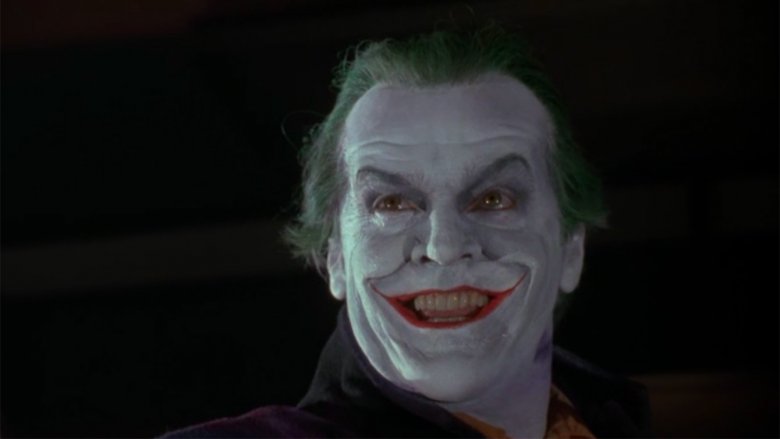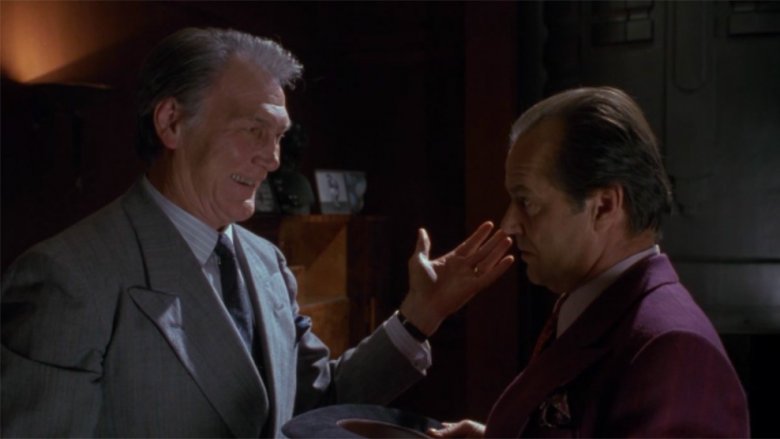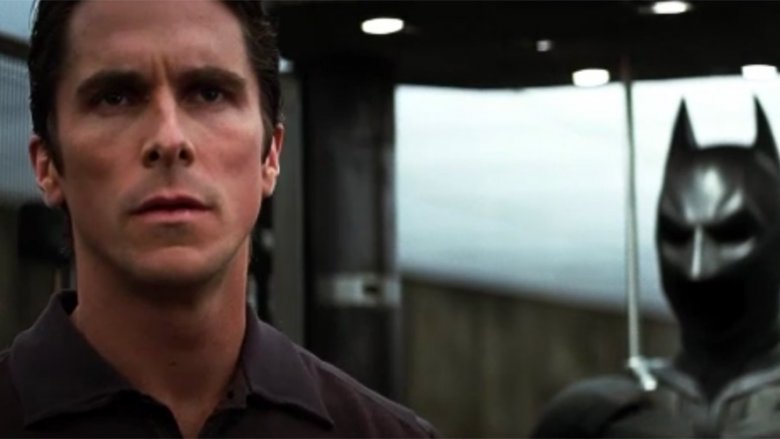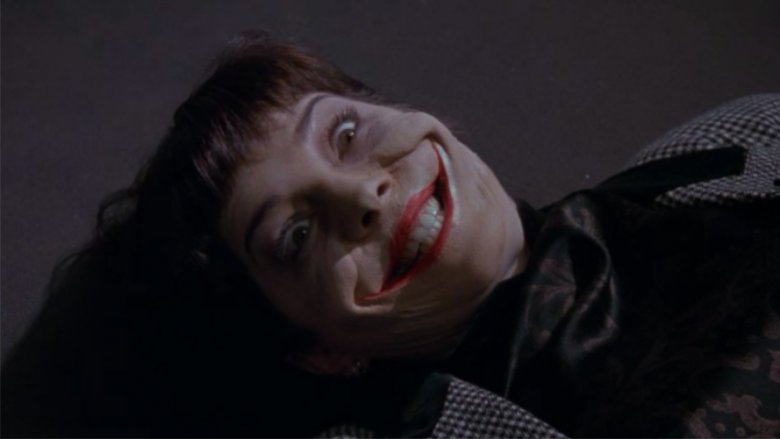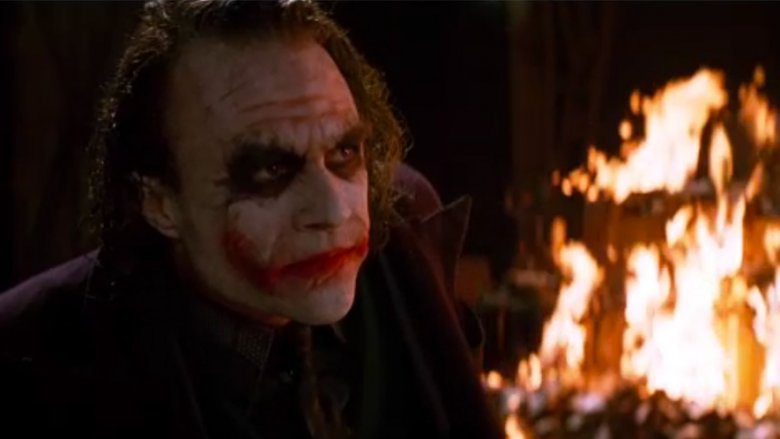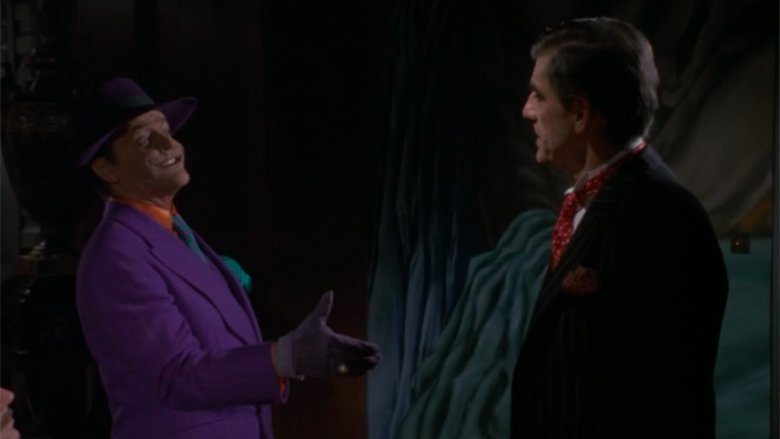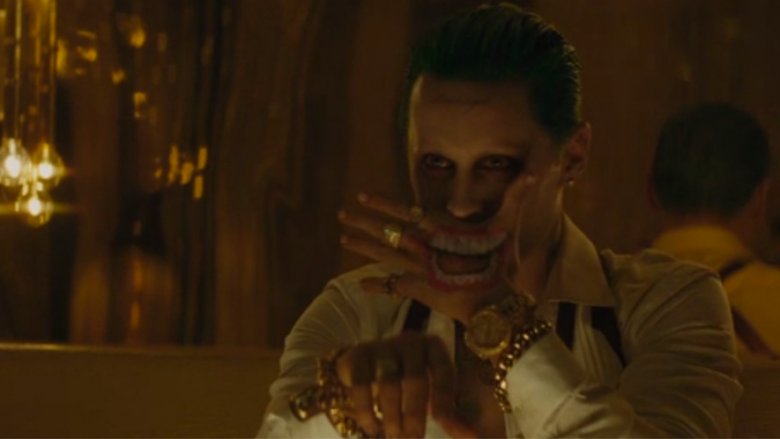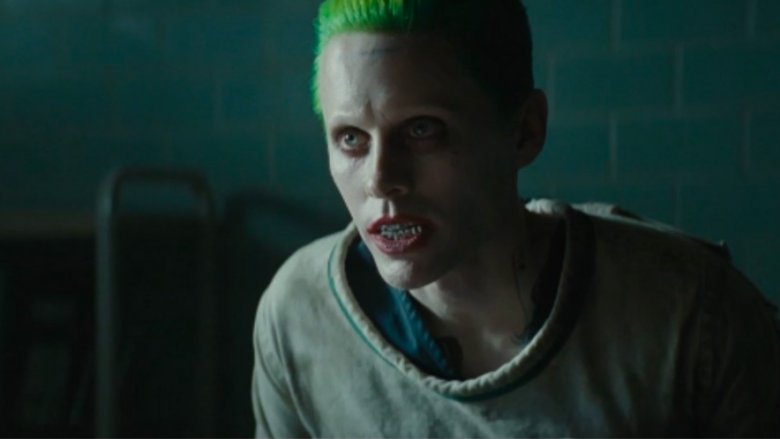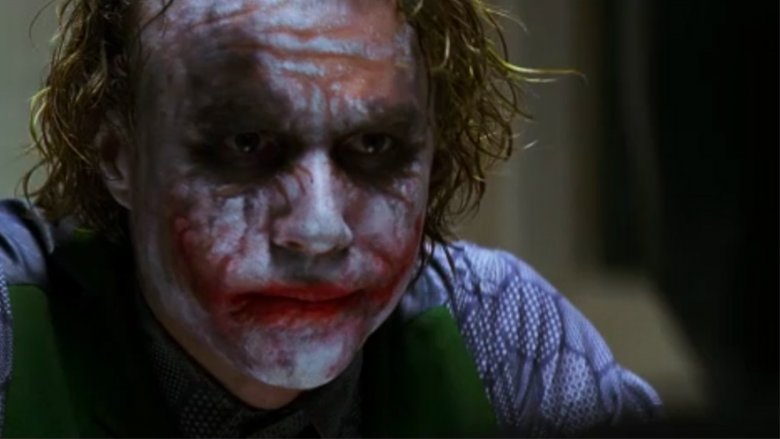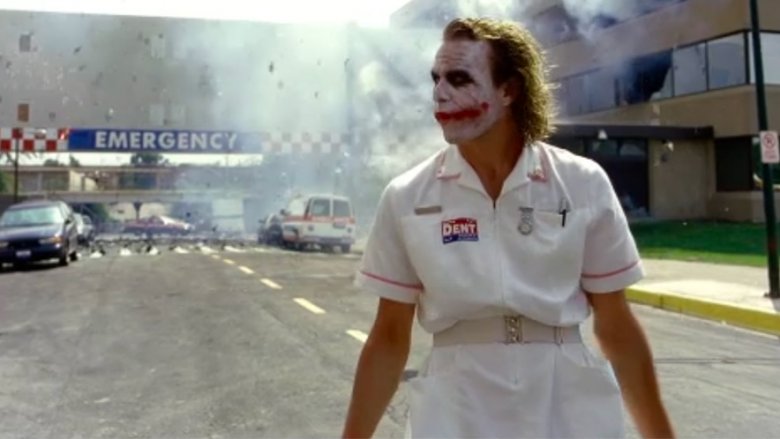Things Movies Always Get Wrong About The Joker
The Joker isn't just Batman's arch-nemesis, he's arguably the single most popular villain in the history of the superhero genre. As a result, he's been a prominent figure in comics ever since he made his debut in 1940's Batman #1, and has been featured in virtually every adaptation of the Caped Crusader's story to ever hit the screen. The only exception is Beware the Batman, a cartoon that specifically made an effort to only use villains that hadn't been seen in any other animated show, and wound up being yanked off the air halfway through its first season.
But even though he's been a fixture of every single big-screen Batman franchise, the cinematic attempts at the Joker have never really lined up with the version that we see in the comics. Even when they're great performances with iconic visuals, there's always something that the movies get wrong about the Joker.
Secret origins
As evidenced by the fact that we've all seen Thomas and Martha Wayne get shot down in an alley about 47 times, superhero movies love to give their viewers an origin story. It's not just for the good guys, either — almost every villain who steps onto the screen brings a whole backstory with them that takes up the majority of the first act. Normally, that's not a problem, and actually gives those villains the pathos that makes for a compelling story. In the Joker's case, however, it's the exact opposite.
The biggest offender in this regard is, of course, Tim Burton's 1989 Batman film, in which Jack Nicholson took on the role of the Clown Prince of Crime. Not only do we get a full origin story, which is even tied back into Batman's own origin so that we can wrap everything up in a nice bow, it's delivered in a way that makes the Joker far less interesting. The problem is that we see that he's a weird, catchphrase-spewing homicidal maniac long before he tumbles into a vat of acid. The only real difference, aside from an admittedly iconic look, is that he gets slightly more artistic with his murders.
For a while, it seemed like the movies had learned their lesson on this front. The Joker that we saw in The Dark Knight shows up fully formed and even offers conflicting versions of his own origin depending on who he's talking to, and Jared Leto's version in Suicide Squad is downright inexplicable. Now, though, we have an entire movie about the Joker's origin, sans Batman, which gives him a name (Arthur Fleck) and an backstory filled with abuse, loneliness, and societal neglect.
Bruce who?
With the Joker's unimpeachable status as Batman's arch-nemesis, it's tempting to connect him not just to the costumed vigilante, but to the millionaire underneath the mask, too. Unfortunately, while that's an idea that makes sense from a traditional storytelling perspective, it's another one of those elements that pretty much misses the point.
The idea that "Batman" is the real Bruce Wayne has been one that fans have long accepted as a truism about the character, and while the actual truth might be a little more complicated than that, it's a good rule of thumb. And yet, the movies treat the Joker, someone who exists specifically in response to Batman, as someone who always has to have that personal connection. Admittedly, they do this with most of the villains as an origin story shorthand — in the Joel Schumacher films, the Riddler and Poison Ivy are both former employees of Wayne Industries — but their backstories are much easier to tie into a large, multinational corporation. The Joker exists specifically to be a counterpoint to Batman — the person under the mask is basically irrelevant compared to the ideological battle being waged against the symbol.
That aspect of the Joker's character, however, is continually missed by the films. In the '89 Batman, it's not enough that the Joker's trying to murder the entire city with a cloud of poison gas, there has to be a personal connection to get the crimefighter into action. Even in the Joaquin Phoenix Joker solo film, Thomas Wayne appears as an antagonist to provide that connection yet again.
Poison smiles
For all its flaws — and the worst of them by far is giving the Joker a name that's a pun on "jackanape" — the '89 Batman movie incorporates one longtime, definitive element of the Joker that no other film does. It's the one that remembers his trademark is poison.
In the movie, it's called "Smylex," but in the comics, Joker Toxin dates back to that first appearance in 1940, and has been a signature of the character ever since. It's fitting that it would be, too. In addition to the outright creepiness of a corpse with a smile frozen on its face, there's nothing that captures the Joker's mission statement quite as succinctly as leaving behind dead bodies in his own image, literally making a world with more death... and more Jokers.
For obvious reasons, the campy, kid-friendly 1966 Batman film didn't involve a lot of poison murders. When Heath Ledger offered up a performance that defined the Joker for a new generation, his weapons of choice were knives, explosives, and complicated moral dilemmas, which left very few people smiling; the 2019 Joker movie, meanwhile, depicts him as initially reluctant to indulge in physical violence, even ineptly mishandling a gun before he finally snaps. The Suicide Squad Joker seems to favor guns and knives as well, which we know from the scene where he's laying on the floor in a weird circle of them that also includes baby clothes, champagne bottles, and laptop computers. It's definitely a striking visual in its own right, but it gets a little less sinister once you start imagining Jared Leto spending hours arranging it all just so.
High (and low) crimes
On one level, you have to hand it to the cinematic versions of the Joker: they always set their sights pretty big. In Batman '89, the Joker attempts to kill the entirety of Gotham during the city's bicentennial, and in The Dark Knight, he tries to trick a literal boatload of citizens into blowing themselves up, and that's after a series of high-profile murders and the bombing of a hospital. The Joker of Suicide Squad doesn't get much screen time, but he's there long enough to establish that he killed Robin. Joaquin Phoenix's Joker is more focused on his own stuff than any sort of large-scale dastardly plot, but his actions still end up sparking widespread mayhem in Gotham. Even in the '60s version, the Joker's part of a plot to kill every delegate to the United Nations, potentially sparking a catastrophic war.
That's not exactly a departure from the comics, either. Since the '80s, the Joker's body count has been ramped up to the extreme, resulting in a character who's only slightly less lethal than, say, the bubonic plague. Even the thing with the UN is something that would eventually make its way into the comics as the part of the "A Death in the Family" story, even if it's always overshadowed by Robin being killed. The thing is, that's not the only thing the Joker does.
While he has a long history of murders, the Joker is also known for his unpredictability. Sometimes he shows up and poisons everyone, and sometimes he applies for a patent on smiling fish and only turns to murder once he's denied. Sometimes he tries to become the first criminal to commit crimes on the moon. A lot of those stories might result from his decades operating under the Comics Code, but that bizarre unpredictability is what makes the Joker work as more than just a slasher movie bad guy.
Disorganized crime
The Joker wasn't the first over-the-top, thematic crook to show up on the comics page, but if you're looking for a place to draw the line between "villain" and "supervillain," he makes a good place to start. His arrival alongside Catwoman in Batman #1 set the standard for costumed criminals, and provided the blueprint that supervillains are still using almost 80 years later. More often than not, though, movies treat the Joker as just a slightly more flamboyant representative of traditional organized crime.
The Joker of Joker is more of a lonely sad sack pushed to his limits, but he's an exception. In Batman '89, the Joker eventually winds up in full-on supervillain mode — complete with an army of henchmen in matching satin jackets — but at heart, Jack Napier is a gangster, and his first actions after his transformation involve taking over the mob. The same goes for The Dark Knight, where the Joker's introduction involves him taking a contract for the murder of Batman, eventually destabilizing the city's organized crime in order to sow chaos. Suicide Squad might actually be the film that goes furthest, showing the Joker as a mob boss holding court in a nightclub that caters to facial tattoo enthusiasts.
Presumably, this is meant to tie the Joker to a more realistic idea of crime, which seems pretty unnecessary. Are audiences only going to accept a genocidal maniac who was turned into a clown by falling into a pit of chemicals and fights a man dressed up as Bondage Dracula if we can relate him to The Sopranos?
Less is more
This is a weird thing to say about a clown in a tailored purple three-piece suit who tends to kill people by the dozens with brightly colored poison gas, but sometimes, less is more.
Since his first film appearance in 1966, the design for the Joker in live action has gotten progressively further over the top. Cesar Romero, for instance, didn't even bother to shave his mustache before caking on the makeup over it. Jack Nicholson was, hairline aside, more-or-less accurate to the comics from a visual standpoint. Heath Ledger combined the traditional purple suit with weird, studiously sloppy face-paint and his infamous scars. And Jared Leto... well, you know. The guy has "damaged" tattooed on his forehead, and that is an aesthetic that doesn't even exist in the same universe as the concept of subtlety. Joaquin Phoenix's Joker, meanwhile, is relatively grounded, spending much of his origin story looking like a regular guy (and appearing admirably creepy when he's slathered in clown makeup).
While the version of the Joker with a smiley mouth tattooed on his hand so that he can cover his mouth and still look like he's smiling — which, sure, why not — is certainly memorable, it's not nearly as effective as the relatively restrained Dark Knight version, and not even close to being as iconic as the simpler Batman '89 style. When there's too much to focus on from a visual standpoint, that visual loses its meaning and just becomes a jumbled mess.
Solo no go
To say that the Joker is a compelling character is understating things quite a bit. He's fascinating, and as a favorite of both fans and creators, he's been examined from every angle over the course of his villainous career. The thing is, well, he's a villain — he's the villain in the Batman franchise — and when you remove him from that context, everything starts to fall apart.
Given that popularity, it might seem like a good idea to tell a story focused entirely on the Joker without bothering to include Batman. We got exactly that when Joaquin Phoenix's Joker film hit theaters in 2019 — and became a wildly profitable hit. Making him the focus, however, changes the role of the character. In the strictest definition, he moves from being the antagonist to the protagonist of the story, which is a move that requires us to identify and empathize with him. For most of us, that's going to be pretty difficult, as we (hopefully) don't often give in to the impulse to, say, poison Gotham City's water supply or beat a teenage vigilante to death with a crowbar. If you change those elements to make him a more sympathetic character, however, you're losing some of what makes the Joker who he is, and if you keep them, you're telling a fundamentally flawed story.
That first option is, of course, not necessarily a bad idea. The Joker, like his heroic counterpart, is the kind of character that's resilient and adaptable enough that he can be used in multiple stories. It's still a gamble, despite DC's best attempts at doing just that in comics. Neither the Bronze Age Joker ongoing series (which only lasted 9 issues) nor the 2008 original graphic novel titled Joker is what you'd call a classic. He's a character who only really works in the context of having Batman around to bounce off of.
We're destined to do this forever
From a structural standpoint, one of the biggest problems with the movie versions of the Joker is more of a problem with movies themselves: they only really use him once.
As a native of a genre that's built on telling ongoing, never-ending stories, the Joker is used best when he's a continual threat. The idea that he's always out there, able to just stroll out of Arkham Asylum and begin his next chaotic crime spree, is a really cool part of his character, just like it is for any comic book supervillain. You never know who's going to make their shocking return, or which mastermind might be manipulating things from behind the scenes in order to make the hero's life a nightmare. That's when the Joker works best — when his exit from the story is at best ambiguous, when no one finds the body, and when you know he'll be back for another round.
Unfortunately, with the very recent exception of the Marvel Cinematic Universe, movies are meant to be more self-contained. Having the Joker linger in the background while a movie focused on less popular and marketable villains would make about as much sense as having Darkseid cooling his heels offscreen while an also-ran like Steppenwolf fought the Justice League in their first big-screen outing. Interestingly enough, there was a thought of doing this during the Dark Knight trilogy — the Joker survives, and the novelization for The Dark Knight Rises even mentions that he is the last remaining inmate of Arkham Asylum. Unfortunately, Heath Ledger's tragic death prevented any of those plans from coming to fruition, leaving his performance as a singular take on the Joker.
The punchline
The Joker's scary. He has to be, right? He's the ultimate creepy clown, a mass murderer plotting death behind his smile, an unpredictable foil for a hero determined to stop him at almost any cost. In all honesty, the movies have that one down — the scene in Batman '89 where the Joker unwraps his face and then shatters a mirror, laughing while a stammering doctor tries to blame his work on a tray full of rusty tools? That's still genuinely unsettling, and a high point of a film that's a whole lot more camp than most people remember.
That said, there's one other thing the Joker ought to be: funny. It really shouldn't be that difficult to pull off, since horror and comedy both rely on a punch of surprise to get their reaction, but it's been a tricky balance for the movies to walk. The closest we've seen to nailing it is, once again, Ledger's performance in The Dark Knight, which pulls off great, actually funny sight gags like the hospital explosion without ever losing that undercurrent of menace. It's a necessary element, recasting Batman as the straight man in an unintentional comedy partnership that usually ends with someone dead.
